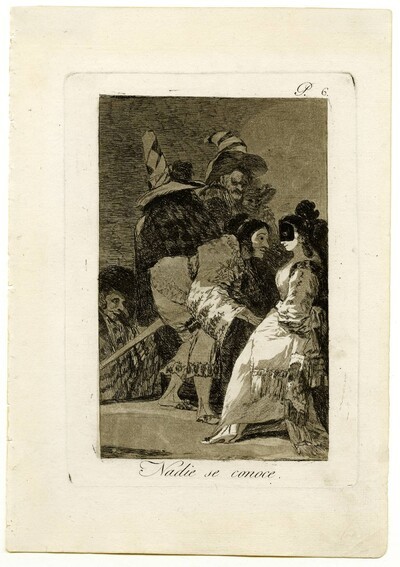- Cronología
- 1815 - 1819
- Dimensiones
- 246 x 357 mm
- Técnica y soporte
- Etching and aquatint
- Reconocimiento de la autoría de Goya
- Documented work
- Ficha: realización/revisión
- 22 Aug 2021 / 05 Jun 2023
- Inventario
- -
See Femenine folly
The aquatint proof in the National Library of Spain has manuscript number 6 in the upper left corner and 21 in the right corner, as well as Carnaval Folly centred in the lower margin.
Carnival scene in which a group of characters are dressed appropriately for the celebration. Their own faces are carnival masks with grimaces and twisted gestures.
On the far left of the composition a man in festive attire points at or shoves a beak-nosed, moustachioed canon. Two other men, in the foreground, cowering and bound in their robes, are talking or shouting at each other. The one on the right has a third eye in his cheek. Next to him, a man with his back turned, wearing a hairnet and a velvet cloak, who could symbolise Spain, watches the spectacle unfolding before him. In the background lies a figure who looks like a Frenchman. Behind him is a conglomeration of human figures, animals and beings with bestialised expressions. Also towering above the group is a hooded man on long stilts.
The meaning of this picture is unknown. It has been suggested that it has a political background. Perhaps it depicts a diplomatic event such as the Congress of Vienna or the interview between the Spanish royal family and Bonaparte in Bayonne, and is therefore an image of the universal political situation after the fall of Napoleon. The two figures in the centre are tied up by higher powers or by their own lasciviousness, giving an erotic sense to the picture.
It can also be interpreted as a satire against social hypocrisy, which leads people to show themselves as what they are not, something that Goya had already denounced in the Caprice 6, Nobody Knows Each Other, although in this case the tone is much more sombre and disturbing. In any case, the theme of the carnival was very popular in 18th-century art, being represented as a joyous occasion. In popular Spanish art, carnival scenes were used as a moralising vehicle, and perhaps this was Goya's intention. The print becomes a mirror reflection in which the viewer looks, observing its dark and grotesque side. In this way, no one escapes Goya's wit.
The print is notable for a certain finesse in the etching. The light is cleverly distributed in strong patches of clarity that give relief to the figures.
-
GoyaMusée Jacquemart-AndréParís1961consultant editor Jean-Gabriel Domergue. From December 1961 to February 1962
-
Etchings by Francosco GoyaJohannesburgoJohannesburgo1974
-
Boston1974
-
1976
-
Grabados de Goya: colección propiedad de la Biblioteca Nacional, que se conserva en su Gabinete deCasa de la Amistad de MoscúMoscow1979exhibition displayed from January 18th to 31st 1979
-
Goya y el espíritu de la IlustraciónMuseo Nacional del PradoMadrid1988from October 6th to December 18th 1988. Exhibited also at Museum of Fine Arts, Boston, January 18th to March 26th 1989; The Metropolitan Museum of Art, Nueva York, May 9th to July 16th 1989, Madrid curator Manuela B. Mena Marqués, scientific directors Alfonso E. Pérez Sánchez and Eleanor A. Sayre
-
Ydioma universal: Goya en la Biblioteca NacionalBiblioteca NacionalMadrid1996from September 19th to December 15th 1996cat. 295
-
Francisco Goya. Sein leben im spiegel der graphik. Fuendetodos 1746-1828 Bordeaux. 1746-1996Galerie KornfeldBern1996from November 21st 1996 to January 1997
-
Goya. 250 AniversarioMuseo Nacional del PradoMadrid1996consultant editor Juan J. Luna. From March 29th to June 2nd 1996
-
Goya grabadorMuseo del Grabado Español ContemporáneoMarbella1996from March 8th to May 5th 1996
-
Zaragoza1996
-
London1997
-
1999
-
Madrid1999
-
Schlaf der Vernunft. Original radierungen von Francisco de GoyaMunich2000
-
Goya en tiempos de guerraMuseo Nacional del PradoMadrid2008consultant editor Manuela B. Mena Marqués, from April 14th to July 13th 2008cat. 181
-
Bilbao2012
-
Goya et la modernitéPinacothèque de ParisParís2013from October 11st 2013 to March 16th 2014cat. 214
-
OxfordBruno Cassirer1964p. 396, cat. 261
-
Vie et ouvre de Francisco de GoyaParísOffice du livre1970p. 326, cat. 1593
-
Catálogo de las estampas de Goya en la Biblioteca NacionalMadridMinisterio de Educación y Cultura, Biblioteca Nacional1996pp. 242-243, cat. 389-391
-
MadridReal Academia de Bellas Artes de San Fernando y Calcografía Nacional1996pp. 107 y 111, cat. 14 y 34
-
Roma Edizioni de Luca2000pp. 136-137, cat. 46
-
MadridMuseo Nacional y Ediciones El Viso2008pp. 486-487, cat. 181
-
ParísPinacoteca de París2013p. 274
-
Goya. In the Norton Simon MuseumPasadenaNorton Simon Museum2016pp. 204-211

